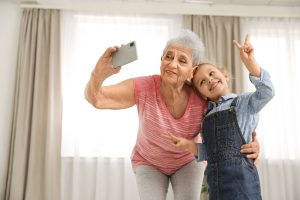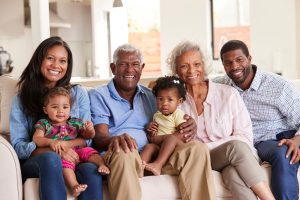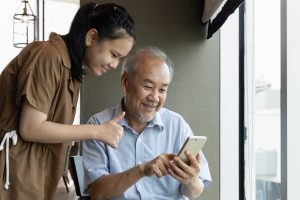 Not that long ago it was commonplace for multiple generations of a family to live together under a single roof. Everyone from grandparents to grandchildren benefitted from close relationships, shared experiences, and diverse perspectives.
Not that long ago it was commonplace for multiple generations of a family to live together under a single roof. Everyone from grandparents to grandchildren benefitted from close relationships, shared experiences, and diverse perspectives.
Today, multigenerational households are an anomaly rather than the norm, and we tend to think of different age groups as very distinct populations that — best case — have little to do with each other, and — worst case — antagonize each other. (Think “Boomers” vs. “Gen Z.”)
This state of affairs is unfortunate for everyone, because — as it turns out — when people from different generations play and learn together, it’s really beneficial for everyone involved.
The Intergenerational Model
The intergenerational model is simply an approach that brings people from different generations together in a shared activity. That activity might be educational or purely social. It might take place in a structured environment, like a school or council on aging facility, or be more community based.
The goal of an intergenerational program is to bridge the gap between different generations — typically seniors and children or young adults — so that they can learn from each other, see the world through different eyes, share their experiences, and sometimes help each other in specific ways.
For example, a program for seniors and teens might include the teens helping the senior participants learn how to use technology while the seniors teach the teens about local history or cooking or some other topic. Sometimes, young and old folks will come together to collaborate on a community project. Whatever the specifics of the experience, there is always an opportunity for learning, sharing, and establishing new friendships.
The Many Benefits of Bridging the Generational Gap
 When different generations come together, everyone benefits. On the surface, these types of programs often provide people from older generations with specific types of assistance. These might include training to learn a new skill or hands-on support with physical tasks. But there are many other layers of benefits as well.
When different generations come together, everyone benefits. On the surface, these types of programs often provide people from older generations with specific types of assistance. These might include training to learn a new skill or hands-on support with physical tasks. But there are many other layers of benefits as well.
For example, seniors often feel isolated because they lack the social interactions associated with the lifestyles of younger people (such as school and work environments). Engaging in an intergenerational program provides a valuable opportunity for interaction, which supports better mental and physical health. Working and playing with young people also helps seniors expand their horizons and maintain cognitive function by encouraging them to see the world through younger eyes, learn about new topics, and try new things.
Children and young people also have a lot to gain from participating in intergenerational programs. Research has found that preschoolers who are partnered with older adult volunteers tend to exhibit increased empathy and greater acceptance, while elementary students show improvement in skills like reading comprehension and writing. Older kids and young adults also often benefit greatly — sometimes in life-changing ways — from the perspective and lessons they gain by listening to elders’ life stories.
Overall, participants young and old typically come away from intergenerational programs with a greater sense of well-being, higher self-esteem, and more confidence. They gain a greater understanding of and connection to their community. They become more empathetic toward and tolerant of people from other generations who may have very different lived experiences.
Examples of Stellar Intergenerational Programs
The possibilities of intergenerational programs are limitless, but here are a few inspiring stories that cover a wide variety of experiences.
Intergenerational Chemistry of Love Class at St. John Fisher University
To improve student participation and capture different perspectives on the subject of love, associate professor and department chair, Dr. Kimberly Chichester, adapted a course on love into a community-engaged learning (CEL) course that partnered first-year students with seniors from the community. All participants gave the experience rave reviews.
Combination High School and Senior Center
 In a small town north of Boston, high school students and senior citizens share space in a single building that is both a high school and a senior center. This intergenerational setting supports both structured and unstructured activities.
In a small town north of Boston, high school students and senior citizens share space in a single building that is both a high school and a senior center. This intergenerational setting supports both structured and unstructured activities.
One formal program is the “Tech Ninjas” program, in which student volunteers teach seniors how to use technology. Students also volunteer in the senior center at the coffee bar and help set up Friday afternoon movies. There are also plenty of opportunities for young and old folks to engage with each other in shared recreational spaces like the mile-long walk around campus.
Generations United is a non-profit organization that is dedicated to improving the lives of children, youth, and older people through intergenerational collaboration, public policies, and programs. Each year they recognize outstanding intergenerational programs across the United States. Here are just a few of their currently highlighted programs:
- The AARP Experience Corps, which empowers people over 50 to serve as tutors to help students become better readers by the end of third grade.
- The AGE to age program in Minnesota, which connects young people with elders and adults in rural areas.
- The Little Brothers Friends of the Elderly Program in Boston, MA, which connects the young and old at free, weekly programs where they build mutually beneficial, joyful friendships.
- The Sharing Time with Elders program in Washington state, which inspires people to bridge the generations through powerful conversations in order to change the social norm of aging and to understand the value of every person at any age.
Considerations for Creating Your Own Intergenerational Experience
Besides all the benefits they deliver to young and old participants alike, one of the most appealing things about intergenerational programs is the fact that anyone can create one. Whether your starting point is a classroom, a senior center, or a general community space, there are countless ways to launch your own program.
It’s often easiest to start with a clearly defined program that serves a specific purpose or focuses on a particular area of interest. This allows you to more easily describe the program to potential participants and volunteers. For example:
- you could start a tutoring program, with either young people tutoring seniors or seniors tutoring kids;
- you could build a program around seniors sharing oral histories of your local community to inspire school children to create their own stories about what community means to them; or
- your program could be service based, partnering teens and young adults to help older folks with errands and other simple tasks while forming natural relationships.
Even if you’re not interested in starting a community-based intergenerational program, you may want to explore if any such programs are already available in your area. Or you may want to create a private, family-sized intergenerational experience by being more intentional about bringing the older and younger generations in your family together in unique ways.
For more details, ideas, and helpful guidelines, Generations United publishes a free Toolkit for Intergenerational Program Planners, that also includes a searchable program database for more ideas and inspiration.
Related Posts:
Multigenerational Vacations: 6 Steps for Planning a Trip Together
 Connecticut Estate Planning Attorneys Blog
Connecticut Estate Planning Attorneys Blog


